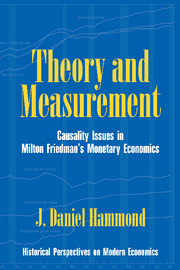Book contents
- Frontmatter
- Contents
- Acknowledgments
- Introduction
- 1 Theory and Measurement at the National Bureau
- 2 Origins of Friedman's Marshallian Methodology
- 3 Origins of the Monetary Project
- 4 Critiques from Within the National Bureau
- 5 Post Hoc Ergo Propter Hoc: Part I
- 6 Reactions to the Monetary History
- 7 Post Hoc Ergo Propter Hoc: Part II
- 8 Friedman and His Critics on the Theoretical Framework
- 9 The Great Depression
- 10 Measurement without Measurement: Hendry and Ericsson's Critique
- Conclusion
- Appendix
- Bibliography
- Index
10 - Measurement without Measurement: Hendry and Ericsson's Critique
Published online by Cambridge University Press: 16 September 2009
- Frontmatter
- Contents
- Acknowledgments
- Introduction
- 1 Theory and Measurement at the National Bureau
- 2 Origins of Friedman's Marshallian Methodology
- 3 Origins of the Monetary Project
- 4 Critiques from Within the National Bureau
- 5 Post Hoc Ergo Propter Hoc: Part I
- 6 Reactions to the Monetary History
- 7 Post Hoc Ergo Propter Hoc: Part II
- 8 Friedman and His Critics on the Theoretical Framework
- 9 The Great Depression
- 10 Measurement without Measurement: Hendry and Ericsson's Critique
- Conclusion
- Appendix
- Bibliography
- Index
Summary
Introduction
Friedman and Schwartz's original 1949 plan for their project envisioned three years' work to measure and analyze the cyclical behavior of monetary and banking phenomena, their relations to cycles in other important variables, and the causal role of monetary and banking phenomena in business cycles for the United States. They expected to have a final report by the end of 1951. As it turned out they worked throughout the first half of the 1950s building their data set. By 1955, with much of the data collection and production done, they were negotiating with Geoffrey Moore, director of research at the National Bureau, over the structure of their report. Friedman envisioned two volumes, one that would be primarily for data presentation and the other for the National Bureau–style analysis of trends and cycles. The data presentation volume would be similar to Burns and Mitchell's Measuring Business Cycles, with heavy emphasis on exposition of their measurements. This volume was eventually published in 1970 as Monetary Statistics of the United States.
Their work on the analytical volume started in earnest in the mid-1950s and continued into the 1960s. The core of what was to be the cycles portion of the volume was published in 1963 as “Money and Business Cycles.” An analytical narrative of the history of money grew from a chapter into the Monetary History (1963b). But the analytical volume was still conceived as a single work on both trends and cycles in 1963.
- Type
- Chapter
- Information
- Theory and MeasurementCausality Issues in Milton Friedman's Monetary Economics, pp. 187 - 207Publisher: Cambridge University PressPrint publication year: 1996

